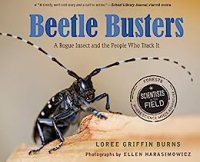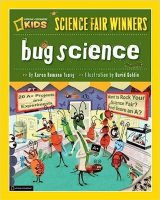
There are more than a million different kinds of insects living on our planet. They live in rivers and deserts and forests and … even our homes … and they outnumber us. So it only makes sense that we get to know them better.
Meet the Bugs:

Buzzkill: A Wild Wander Through The Weird And Threatened World Of Bugs by Brenna Maloney
Reading this book is like listening to a friend tell stories. For example, there’s the time Brenna bought caterpillars watched their transformation into adult painted lady butterflies. She gives her personal take on insect defenses (getting stung), wrangling ants into an ant farm, and more.

1,000 Facts about Insects by Nancy Honovich
This browsable book is perfect for the kid who wants to know cool insect facts without reading an entire book. Each spread focuses on some aspect of the insect world, from life cycles to senses to defenses. There are facts about migration, endangered insects, and conservation, about light-makers and love bugs, 50 fluttering facts about butterflies and lots, lots more.

Encyclopedia of Insects: An Illustrated Guide to Nature’s Most Weird and Wonderful Bugs by Jules Howard, illustrated by Miranda Zimmerman
After some basic information and a list of some amazing insect feats, the book groups over three hundred insects by their orders. It provides the common and scientific names, size, diet, location and interesting details for some colorfully painted familiar and freaky insects from around the world. You’ll also find information on arthropods and invertebrates and a handy guide to determine whether you are an insect.

Moth: An Evolution Story by Isabel Thomas, illustrated by Daniel Egnéus
One of the most remarkable stories about natural selection is that of how the pepper moth adapted to the sooty pollution of the industrial revolution. Evolution is a big concept, hard to grasp sometimes, and this book does a marvelous job telling – and showing – how environmental changes affect insect populations. A picture book for the 8-10 crowd.

The Beekeepers : How Humans Changed the World of Bumble Bees by Dana L. Church
Bumble bees are a vital part of our ecosystems, pollinating crops that feed people and wildflowers and trees that feed wildlife. They are so successful, that people have commercialized their breeding, shipping bumble bee colonies to greenhouse growers across state – and country – borders. But what happens when commercially raised bumble bees escape the greenhouse and begin nesting in the wild?
For another book about bees, check out our interview on Where have all the bees gone? : pollinators in crisis, by Rebecca E. Hirsch from a couple years ago.

Wicked Bugs: The Meanest, Deadliest, Grossest Bugs on Earth by Amy Stewart
Engaging and terrifying, this book explores the life cycles, habits, and dangers of forty-eight of the deadliest, dangerous, unwelcome, destructive, painful, and seriously threatening insects on earth – plus a few spiders, worms, and scorpions for good measure. It includes case studies of recent and historic instances of attacks or bites from these insects and any known treatments. Not for the faint of heart, though it is a good resource for identification, insect transmitted diseases and pest control.
Meet The Folks Who Study Them (Entomologists):

Beetle Busters: A Rogue Insect and the People who Track It (Scientists in the Field) by Loree Griffin Burns, photos by Ellen Harasimonwicz
The Asian Longhorn Beetle came to the US as a stowaway, tucked into wood used to ship products. With no natural enemies to control its spread, the beetle now infests trees from Massachusetts to New York and into Ohio, with the potential to cause more damage than Dutch elm disease, chestnut blight and spongy moths combined. This book follows the scientists tracking the insect and trying to save the forests.

Buzzing with Questions: the inquisitive mind of Charles Henry Turner by Janice N. Harrington, illustrated by Theodore Taylor III
At a time when most colleges didn’t accept black students, Charles Turner went to study zoology. He had a particular fondness for small creatures, insects, and used them to help answer big questions: how do ants find their way home? Can an insect solve a maze? Can bees learn to identify colors? This book will inspire emerging entomologists of all ages.

Beetle Battles: One Scientist’s Journey of Adventure and Discovery by Douglas J. Emlen
Doug Emlen studies antlers, horns, tusks… weapons that just happen to belong to dung beetles. The cool thing about beetle weapons, he says, is their diversity: some are stubby, some long and slender, some like crowbars, some like sabers. Emlen shows readers how science happens in the field, from designing experiments and collecting data to rethinking the experiments (when they don’t work), and doing it all again.

Naturalist: A Graphic Adaptation by Edward O. Wilson and Jim Ottaviani, illustrated by C.M. Butzer
E.O. Wilson is an insatiably curious biologist, well-known for his work on ants and insect societies. He reminisces about childhood expeditions to the creek with friends, and an effort to collect and study “all the ants in a vacant lot.” Ants may be small, but examining their societies led Wilson to ask big questions about social structure, genetics, and biogeography.

The Forensic Entomologist by Diane Yancey
A fascinating examination of the history (a collection of cases through time) and the numerous insects that have solved both murders and trafficking cases. It offers a look at the education and procedures for forensic entomologists and medical examiners, a detailed exploration of how bugs illuminate the time of death, location of death, DNA of victim, and neglect, and explores the factors that can cause mistakes and future forensic applications.
Bug Field Guides and Activities:

Ultimate Explorer Field Guide: Insects (National Geographic) by Libby Romero
Divided into two sections – Incomplete Metamorphosis and Complete Metamorphosis – this book is loaded with information, photos, jokes, challenges, and interesting behaviors or facts, as well as any bite, sting, or chemical reaction danger an insect poses. Interspersed throughout are double spread “Insect Reports” on wings, bug vs. insect, invasive species, and much more. The introductory information, Quick Id Guide, glossary, and additional resources round out this engaging insect guide.

Insects and Arachnids (Field Guides) by Carla Mooney
After defining each and their roles in nature, vivid photographs accompany descriptions and fascinating side bars, as well as “How to Spot” and “Fun Facts” sections for each insect, spider, and other critter. Easily browsable, it is divided into the categories: True Flies, Beetles, Wasps and Bees, Ants, Moths and Butterflies, True Bugs, Spiders, Ticks and Mites, and Scorpions.

Bug Science: 20 Projects and Experiments About Arthropods: Insects, Arachnids, Algae, Worms, and Other Small Creatures by Karen Romano Young, illustrated by David Goldin
A tongue and cheek presentation, full of cartoonish illustrations, guides kids though the scientific process (concept, question, plan, materials, procedure, and recording of data) necessary to perform experiments with flies, ants, butterflies, fleas, spiders, and other creatures.
This month’s STEM Tuesday book list was prepared by:

Sue Heavenrich, who writes about science for children and their families on topics ranging from space to backyard ecology. Bees, flies, squirrel behavior—things she observes in her neighborhood and around her home—inspire her writing. Her most recent book is Funky Fungi (with Alisha Gabriel). Visit her at www.sueheavenrich.com.

Maria Marshall, a children’s author, blogger, and poet who is passionate about making nature and reading fun for children. When not writing, critiquing, or reading, she watches birds, travels the world, bakes, and hikes. Visit her at www.mariacmarshall.com.

 If you’re not familiar with E Train, the preteen literacy advocate, booktuber and podcast host, now’s your chance! Six months shy of his thirteenth birthday, this soon-to-be Bar Mitzvah boy has been reviewing books, interviewing authors, and spreading kindness—virtually and in-person—since the age of nine and a half (!). Today, it is my absolute pleasure to welcome E Train (aka Ethan) to the Mixed-Up Files.
If you’re not familiar with E Train, the preteen literacy advocate, booktuber and podcast host, now’s your chance! Six months shy of his thirteenth birthday, this soon-to-be Bar Mitzvah boy has been reviewing books, interviewing authors, and spreading kindness—virtually and in-person—since the age of nine and a half (!). Today, it is my absolute pleasure to welcome E Train (aka Ethan) to the Mixed-Up Files.
















 Josh: I don’t know how much Sara knows about coding, but as is often the case in the picture book world, I didn’t give much direction at all to Sara when illustrating. And as is also often the case, what Sara came up with was brilliant. The illustration of the loop in the beach blowup was an awesome surprise to see when I first saw the sketches – perfectly encapsulating the visual of a loop!
Josh: I don’t know how much Sara knows about coding, but as is often the case in the picture book world, I didn’t give much direction at all to Sara when illustrating. And as is also often the case, what Sara came up with was brilliant. The illustration of the loop in the beach blowup was an awesome surprise to see when I first saw the sketches – perfectly encapsulating the visual of a loop! But Sara was our top choice for illustrator and I am so thrilled that she was able to make time in her very busy schedule to work on these books. Side note – she was a superstar for getting it done in a very timely fashion. It was critical that this book come out before summer (as it was a beach-themed book), so if the book hit any delays, it would have had to be bumped an entire year (as they weren’t gonna release it October).
But Sara was our top choice for illustrator and I am so thrilled that she was able to make time in her very busy schedule to work on these books. Side note – she was a superstar for getting it done in a very timely fashion. It was critical that this book come out before summer (as it was a beach-themed book), so if the book hit any delays, it would have had to be bumped an entire year (as they weren’t gonna release it October).

